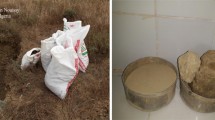Abstract
Saline soil has imposed a serious threat on many expressway engineering and agricultural areas. This paper describes the performance of saline soil treatment using electrokinetic remediation technology. Comparison study involving sample soil and in situ soil is carried out. Two different electric fields, i.e., uniform and non-uniform are utilized to promote the migration of inorganic ions contained in the soil toward the electrode area. The effects of different electric field types and potential gradient ion migration rate in soil are investigated. The test result reveals that a uniform electric field of a constant potential gradient of 1 V/cm drives the Cl− through the sample soil at a rate of 1.36 cm/h. Moreover, larger potential gradients could make ions migrate faster, but more electrical energy is consumed in such a way. Compared with uniform electric field, the non-uniform process maintains the soil pH values more effectively and consumes less electrical energy. A desirable result of removing Na+ in soil is expected using electrokinetic remediation technology under four-times scaling up of soil volume.
Similar content being viewed by others
References
Metternicht G, Zinck J A. Remote Sensing of Soil Salinization: Impact on Land Management. Boca Raton: CRC Press, 2008
Hasanuzzaman M, Nahar K, Alam M, Bhowmik P C, Hossain M A, Rahman M M, Prasad M N V, Ozturk M, Fujita M. Potential use of halophytes to remediate saline soils. BioMed Research International, 2014, 2014(10): 1–12
Liu Y, He W, He J, Shen Z. Progress of improvement and utilization of saline-alkali land. Journal of Agricultural Sciences, 2007, 28(2): 68–71 (in Chinese)
Zhu H, Xie W. Shallow reviews on improvement measures of saline-alkali land. West-China Exploration Engineering, 2013 (3): 123–125 (in Chinese)
Li Y B, Xu Q T. Study on the effect of the use of FGD gypsum into the alkalization soil to improve soil property. Applied Mechanics and Materials, 2013, 448(453): 482–487
Wang L, Chen M, Qiang Z, Zhou H, Zheng P, Jiang S. Effects of desulfurised gypsum from coal power station on improvement of saline-alkali soil. Chinese Agricultural Science Bulletin, 2011, 27(20): 241–245 (in Chinese)
Tozsin G, Arol A I, Cayci G. Use of waste pyrite as an alternative to gypsum for alkaline soil amelioration. International Journal of Mining, Reclamation and Environment, 2015, 29(3): 169–177
Zhang G, Gang C. Study on electrokinetic remediation of heavy metal contaminated soil. Science and Technology Innovation Herald, 2013, 1: 105–106 (in Chinese)
Long C, Zhou D. Electrokinetic treatment of a chromium contaminated yellow brown soil as affected by voltage. Acta Pedologica Sinica, 2005, 42(6): 999–1005 (in Chinese)
Xia J. Numerical simulation of ionic transport in cement paste under the action of externally applied electric field. Constructions and Building Materials, 2013, 39: 51–59
Anderson R. Resource Guide for Electrokinetics Laboratory and Field Processes Applicable to Radioactive and Hazardous Mixed Wastes in Soil and Groundwater from 1992 to 1997. Washington D. C.: U.S. Environmental Protection Agency-Office of Air and Radiation, 1997, 7–29
Chang J H. Removal of selected nonionic organic compounds from soils by electrokinetic process. Dissertation for the Doctoral Degree. Newark: Delaware University, 2000
Ju L. Efficiency of biosurfactants applied by means of electrokinetics. Dissertation for the Doctoral Degree. Montreal: Concordia University, 1999
Röhrs J, Ludwig G, Rahner D. Electrochemically induced reactions in soils—a new approach to the in-situ remediation of contaminated soils?: Part 2: remediation experiments with a natural soil containing highly chlorinated hydrocarbons. Electrochimica Acta, 2002, 47(9): 1405–1414
Vane L M, Zang G M. Effect of aqueous phase properties on clay particle zeta potential and electroosmotic permeability: Implications for electrokinetic soil remediation processes. Hazardous Materials, 1997, 55(1–3): 1–22
Yeung A T, Hsu C N, Menon R M. Physicochemical soil-contaminant interactions during electrokinetic extraction. Hazardous Materials, 1997, 55(1–3): 221–237
Page M M, Page C L. Electroremediation of contaminated soils. Environmental Engineering, 2002, 128(3): 208–219
Azzam R, Oey W. The utilization of electrokinetics in geotechnical and environmental engineering. Transport in Porous Media, 2001, 42(3): 293–314
Acar Y B, Alshawabkeh A N. Electrokinetic remediation I: Pilot-scale tests with lead-spiked kaolinite. Journal of Geotechnical Engineering, 1996, 122(3):173–185
Chilingar G V, Loo W W. Electrobioremediation of soils contaminated with hydrocarbons and metals. Energy Sources, 1997, 19(2): 129–146
Baraud F, Tellier S, Astruc M. Temperature effect on ionic transport during soil electrokinetic treatment at constant pH. Hazardous Materials, 1999, 64(3): 263–281
Luo Q, Hui W. The mobilization of inorganic ions in soil by the action of non-uniform electric field. China Environmental Science, 2004, 24(5): 519–523
Zhang R X. Study on variation and infulence factors of soil resistivity in electrokinetic remediation of saline soil. Dissertation for the Doctoral Degree. Yangling: Northwest A&F University, 2014 (in Chinese)
Pohl H A. Dielectrophoresis: The Dehavior of Neutral Matter in Non-Uniform Electric Fields. London: Cambridge University Press, 1978, 6–15
Lee H H, Yang J W. A new method tocontrol electrolytes pH by circulation system in electrokinetic soil remediation. Hazardous Materials, 2000, 77(1–3): 227–240
Luo Q S, Wang H, Zhang X H, Qian Y. Movement and transformation of nitrate in soil by non-uniform electrokinetic. Environmental Sciences, 2004, 2: 98–103 (in Chinese)
Acknowledgements
The authors express sincere appreciation to anonymous reviewers for their valuable comments on improving this study. The study was jointly supported by grants from the National Natural Science Foundation of China (Grant Nos. 51779134, 51579142), Program for Chang-jiang Scholars and Innovative Research Team in University of China (No. IRT13075), and Shandong Province Transportation Science and Technology Project (No. 2008Y002).
Author information
Authors and Affiliations
Corresponding author
Rights and permissions
About this article
Cite this article
Li, X., Wang, L., Sun, X. et al. Analysis of mobilization of inorganic ions in soil by electrokinetic remediation. Front. Struct. Civ. Eng. 13, 1463–1473 (2019). https://doi.org/10.1007/s11709-019-0569-8
Received:
Accepted:
Published:
Issue Date:
DOI: https://doi.org/10.1007/s11709-019-0569-8




